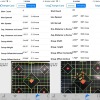There's no way I could shoot a meaningful 20 shot group at our range unless there was no wind, mirage, water vapor, and all the stars and moon were aligned in a single row. Also, I would not have had any coffee for 5 days, and before that, Decaf for a month.
When I shot my 50 shot target, consisting of 10, 5 shot groups, conditions were perfect, but group center varied somewhat, from group to group, so something was happening. That's why I think you math guys may be wrrrr, wrrr, wrong. But, I wouldn't say that in a room full of math nuts.
When I shot my 50 shot target, consisting of 10, 5 shot groups, conditions were perfect, but group center varied somewhat, from group to group, so something was happening. That's why I think you math guys may be wrrrr, wrrr, wrong. But, I wouldn't say that in a room full of math nuts.





